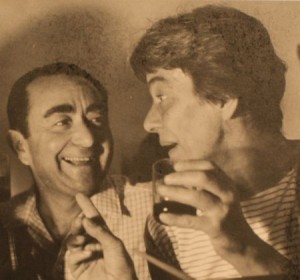When Gitta Mallasz arrived in France in 1960, she already spoke French. "Everything is calculated up there! My mother spent seven years in a French convent in Austria. She often spoke to us in that language, which she loved. But her French was still only approximate, or at least not good enough to translate such a dense and poetic text.
It will therefore involve an impressive number of people.

There were those who spoke Hungarian, like her husband, Laci Walder, who met her Angel and fully embraced his wife's work. There was also, Marguerite Kardos recalls, a group of Hungarian women of whom she was a member and who met from August 1965 at Gitta's home or at the home of one of them (or, in summer, on the benches in the Parc de Sceaux): Eva Péterfalvy, Rosy Rey, Vera Székely [1], artists. Some are "lame bilinguals", others have been in France for 20 years and know French perfectly, but all are very demanding and enthusiastic.
But many did not speak Hungarian at all. This is the case of Hélène Boyer, mentioned in the 1976 edition as having collaborated on the translation, and Father Henri Ormaechea, a Franciscan who was seduced by the text. He recounts the weekly sessions - veritable ping-pong matches - that went on for two years to prepare the first edition in 1976:
She would start reading out loud. She'd say, "That's badly translated". Or "That's not good enough". Then I'd make some translation suggestions. She'd say, "No, that's not it yet - or quite it". We'd beat around the bush and then, when the right suggestion came along, she'd say, "That's it! And she'd write it down straight away.

Dominique Raoul-Duval [2], for her part, recounts with humour and emotion the "unforgettable experience" of working with Gitta on the complete edition of the Dialogues with the angel and for two of the four commentary books:
Our method was simple: since Gitta's prose was often approximate, with a haphazard syntax and uncertain vocabulary, the same question kept recurring, from sentence to sentence: "What exactly did you mean?
Gitta explained at length, and we found, by trial and error, the words that fitted her thoughts exactly.
The years I'd spent in publishing, working on other people's texts, had made me demanding: a hundred times Gitta would have stopped along the way, content with the imperfect formula I'd just suggested to her; a hundred times, obstinately, I would assert that we could find better - and we did find better, indeed.
To discover the complete testimonies of Father Henry and Dominique Raoul-Duval: from Hungarian to French, on www.dialogues-ange.fr
[1] Vera Székely (1919-1994) was a Hungarian artist who started out as a swimmer. She was trained by Gitta Mallasz until taking part in the 1936 Berlin Olympics. She then became Hanna's pupil, along with Pierre Székely, who was to become her husband. During the Budaliget talks, they lived in Hanna's parents' flat in Budapest and were the first readers of what was to become the Talking with Angels. They will settle in France after the war.
[2] Dominique Raoul-Duval was in charge of publishing six white-cover books at Aubier over a period of 17 years: the two editions of Dialogues with the angel and the four commentary books by Gitta Mallasz.
EL
